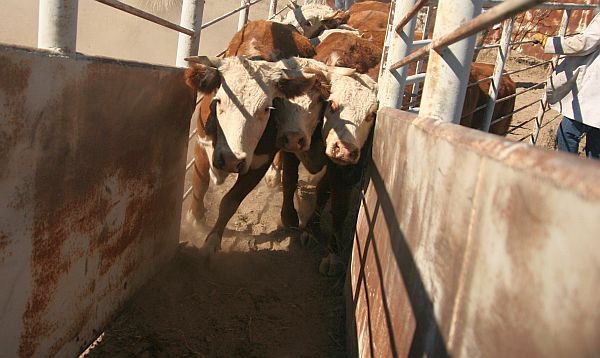Presidio, Texas ó In 2012 the federal government banned US Department of Agriculture inspectors from entering Mexico at five Texas border crossings to inspect US-bound cattle.
The decision has had a huge economic impact on small border towns in Texas, in particular the city of Presidio that sits across from Ojinaga, Chihuahua, Mexico. The international port of entry here had been the largest for cattle imports from Mexico into the United States for eight decades.
Until 2012, the USDA routinely sent inspectors across the border to a state-of-the-art building on the other side of the Rio Grande in Ojinaga. About 2,500 head were checked every weekday and sent on to US customers. But politicians from Texas and other states raised concerns over border violence.
Even the Texas Agriculture Commission entered the fray. An agency website claims that the 1,200 mile border that Texas shares with Mexico is a "hot spot" for cartel violence. Agriculture Commissioner Todd Staples says the USDA ban, one that federal officials said in October will continue indefinitely, is justified.
"Until the Mexican government can control the violence and guarantee the safety of our federal employees," he said, "I have to agree that we should not send them in harmís way across the border."
But the ban has had real economic consequences here. Cattle broker Salvador Baeza at the Presidio stockyard says the economic fallout in Presidio totals $5 million and counting. "Presidioís losing a lot of money thatís supposed to stay in town. The stores are losing money," Baeza said. "Everybodyís losing money."
Hereís why. The inspection pen on the Texas side of the Rio Grande is a makeshift affair that canít handle more than 700 head per week, a far cry from the 2,500 every day before the USDA decision. So Mexican producers ó among the largest exporters of cattle to the United States, accounting for 25 percent of all beef imports ó are now trucking their cattle to a USDA inspection site across the border in New Mexico, a rough journey of over four hours.
Alberto Attolini of the Chihuahua Cattle Producers Association in Ojinaga said the Presidio/Ojinaga crossing had worked well for 90 years before the USDA pullout. "The people not just from Chihuahua but from 11 other states from Mexico come through here," Attolini said.
Attolini says the makeshift Texas inspection site is too small to make the trip worthwhile. He doesnít understand the security concerns. Ojinaga, he says, is relatively tranquil and crime statistics support that claim.
Moreover the four hour journey to Santa Teresa, New Mexico stresses the animals to the point they lose weight and therefore value on the trip. "They lose a lot of weight," Attolini said. "They say around 5 to 7 percent. And thatís the reason why weíve lost a lot of money to be inspected here in the United States."
The USDA has said that the agency hopes eventually to return to Ojinaga and other shuttered Mexicans stations. But it stands by its decision, citing unspecified threats. Meanwhile the inspection ban will likely have economic consequences that stretch far beyond this remote border region.
Jim Dunn is an economist at Penn State Universityís College of Agricultural Sciences. He said if you like fast food, you may have to pay more for your hamburger should the ban continue much longer.
"We buy a lot of cattle from other countries. And Mexico has historically been the most important source for those international cattle," Dunn said. "A lot of that cattle comes into the United States and become hamburger. So itís a big balance of our livestock industry. We sell them high quality meat for steaks for the fancy resorts and we buy a lot of hamburger from them."
Cattle producers say that the traditional arrangement has been crippled by the inspection ban. Cattle producers from both countries are meeting to craft their own security plan they hope will convince Washington that cross border inspections are safe.
Original Story


